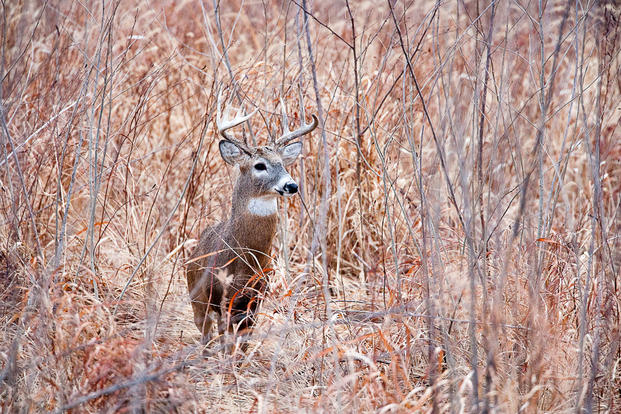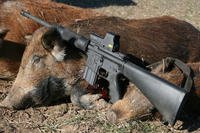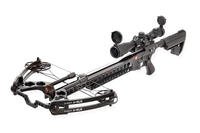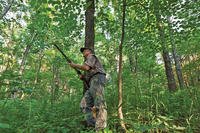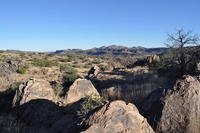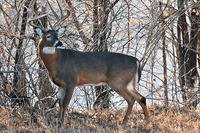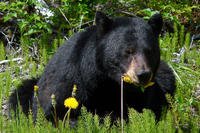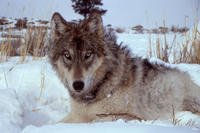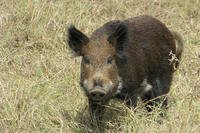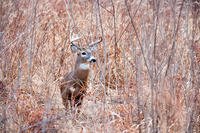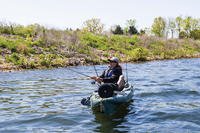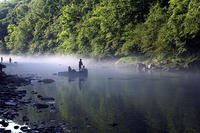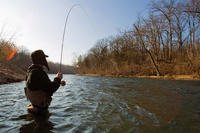Sweat was dripping from my brow as I leaned up against a tree for a much-needed rest. Deep snow and vertical mountain slopes created the excess perspiration, not hot fall temperatures. The scent of pine wafted on the breeze, sending shivers through my body. As my breathing returned to normal, I caught sight of movement to the right. A dainty doe bounded through the deep snow, almost in a playful manner. Was she bounding away from me or from another intruder? I didn't have to mentally answer the question, as a whitetail buck busted through the snow right behind her. I lifted my .243, picked an opening in front of the buck and fired as he sped past. Was my aim true? Hustling over to the tracks brought on another round of sweat and disappointment — no hint of blood.
That hunt took place more years ago than I care to remember, but it was my first taste of mountain whitetail hunting. I've always had a soft spot for mountains, and the opportunity to hunt whitetails on the slopes lures me whenever the chance arises — despite the hardships mountain hunts present.
Mountain Living
Whitetails in the vertical mountain zone lead a different lifestyle than their woodlot brethren. They still require the basic necessities of life — food, water and shelter — but they have no problem shopping for these daily requirements in a different zip code as the seasons change. In short, mountain whitetails move to get what they need, and they're not afraid to break the one-square-mile-home-territory rule.
The two elements requiring big movements include food and shelter. Water is generally available throughout mountain ranges in the form of springs, streams, ponds and, at times, snow. The same can't be said of food. Most forests have considerable quantities of conifers that create a dense canopy that allows little light to reach the ground for browse to sprout. In addition, the acidic nature of conifer needles does little good for soil conditions.
Forage thus comes from meadows, valley farm fields, creekside browse and scattered mast production. During the spring, summer and fall, mountain whitetails spread throughout the range to take part in the abundant bounty, but when snows invade high elevations, whitetails need to migrate to food. Valleys that harbored the occasional whitetail soon become a metropolis of whitetail activity.
In my backyard of the Bighorn Mountains of Wyoming, this is visible each year as whitetails drop from the face of the mountain to take advantage of hayfields and other agricultural ventures from summer farming efforts. As snow piles up, regardless if it is in the Appalachians east of the Mississippi River or the Kaniksu National Forest in Idaho, whitetails will return to traditional wintering areas after dispersing for the summer.
Equally important as food is shelter. Although the mountains have unlimited nooks of whitetail cover, from October through April deer might have to vacate the premises due to heavy snow cover. Shelter and food fall hand-in-hand as animals drop in elevation to the meadows and valleys below. Resident whitetails suddenly have to contend with an influx of mountain cousins, and it's not uncommon for a favorable location to double in population after a heavy snow event. Brushy draws and south-facing foothill slopes suddenly come alive with deer seeking winter shelter.
Although the vast majority of whitetails will abandon the high country, a few mature bucks might inhabit micro-environments with ample features that allow a few animals enough ingredients to survive a tough winter. Instead of dropping to the valley below, bucks might hold up on broad, south-facing slopes that melt off with solar daytime heating. They glean moisture from snow and browse on forage scattered on the hillside.
What does all this mean to the mountain whitetail hunter? You need to be fully aware of changing conditions and how they are affecting the local whitetail population. Whitetails you scouted in summer and focused on during early season archery hunts might suddenly have taken a "Beverly Hillbillies" cross-country trip.
Since hunting seasons occur during the window when snow is likely to inhabit the high country, you're likely to be smack in the middle of a major whitetail movement. Bucks here today are gone tomorrow, and only the observant and reactive whitetail hunters find success.
Mountain Gear
Every trip into the mountains isn't a life-or-death situation, but it doesn't hurt to plan for the worst. Mountain whitetails will test you in different arenas than Midwest whitetails. Let's begin with their environment. It's unforgiving. You'll encounter vertical slopes with grades of 50 percent or more if you access remote country. One of the most demanding whitetail hunts for me to date took place in the mountain slopes of the Snake River in western Idaho. Whitetails had no issues with running straight up to escape like the wily chukar partridge that also inhabited the unrelenting slopes. Meadows and whitetail cover existed on a vertical plane, and to be successful, you had to be in marathon shape. It wasn't a hunt for the stump sitter who totes a folding chair and a large thermos of coffee to every stand.
This illustrates the need to move away from traditional hunting gear and instead look at the gear mountain hunters use for mule deer, elk and even sheep. Begin with gear that helps you, not the hunt. First, invest in a quality GPS that's easy to use and gives you quick coordinates from hunting camp to whitetail hotspots. Garmin's Oregon series offers one of the easiest to use formats that includes touch-screen technology, digital maps, wireless route exchange, computer interface capabilities, trip computer modes and various other features, so you'll always know your location. Extra batteries as well as a compass and topographic map are also recommended. In addition, I rely on my Garmin Rhino GPS for its two-way radio feature and ability to capture weather forecasts from the National Oceanic and Atmospheric Administration. Mountain weather changes faster than Hollywood couples, with more serious consequences.
A GPS will tell you where you're at, but what if you have to spend an unexpected night on the mountain? Take along a survival kit. A lightweight survival kit with first aid, fire-starting elements and emergency shelter can make a cold night on the mountain almost downright comfy.
Unlike Midwest hunts where a daypack might suffice, look into an internal frame pack capable of packing in your gear and packing out a buck. Many areas will require you to debone your deer and freight it out on your back. An attached scabbard is also handy if you need to stow your weapon and use two hands to scale a mountain hunting zone.
Hunting boots should also be researched. One word of advice — forget about knee-high rubber boots. You'll need boots with aggressive soles, ankle support and waterproof, breathable Gore-Tex lining. Although scent-free qualities are warranted, rubber boots will eat your feet alive.
